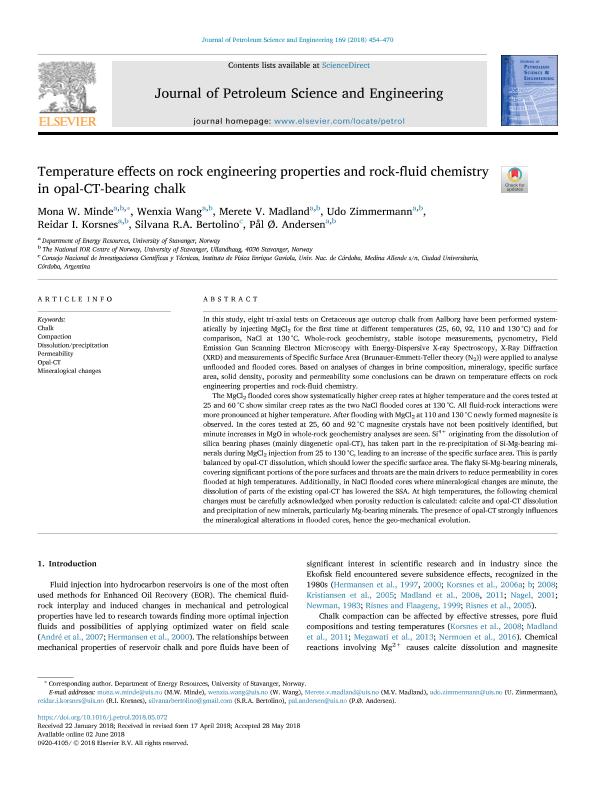Mostrar el registro sencillo del ítem
dc.contributor.author
Minde, Mona W.
dc.contributor.author
Wang, Wenxia
dc.contributor.author
Madland, Merete V.
dc.contributor.author
Zimmermann, Udo

dc.contributor.author
Korsnes, Reidar I.
dc.contributor.author
Bertolino, Silvana Raquel Alina

dc.contributor.author
Andersen, Pål Ø.
dc.date.available
2019-12-05T22:47:29Z
dc.date.issued
2018-10
dc.identifier.citation
Minde, Mona W.; Wang, Wenxia; Madland, Merete V.; Zimmermann, Udo; Korsnes, Reidar I.; et al.; Temperature effects on rock engineering properties and rock-fluid chemistry in opal-CT-bearing chalk; Elsevier Science; Journal Of Petroleum Science And Engineering; 169; 10-2018; 454-470
dc.identifier.issn
0920-4105
dc.identifier.uri
http://hdl.handle.net/11336/91570
dc.description.abstract
In this study, eight tri-axial tests on Cretaceous age outcrop chalk from Aalborg have been performed systematically by injecting MgCl2 for the first time at different temperatures (25, 60, 92, 110 and 130 °C) and for comparison, NaCl at 130 °C. Whole-rock geochemistry, stable isotope measurements, pycnometry, Field Emission Gun Scanning Electron Microscopy with Energy-Dispersive X-ray Spectroscopy, X-Ray Diffraction (XRD) and measurements of Specific Surface Area (Brunauer-Emmett-Teller theory (N2)) were applied to analyse unflooded and flooded cores. Based on analyses of changes in brine composition, mineralogy, specific surface area, solid density, porosity and permeability some conclusions can be drawn on temperature effects on rock engineering properties and rock-fluid chemistry. The MgCl2 flooded cores show systematically higher creep rates at higher temperature and the cores tested at 25 and 60 °C show similar creep rates as the two NaCl flooded cores at 130 °C. All fluid-rock interactions were more pronounced at higher temperature. After flooding with MgCl2 at 110 and 130 °C newly formed magnesite is observed. In the cores tested at 25, 60 and 92 °C magnesite crystals have not been positively identified, but minute increases in MgO in whole-rock geochemistry analyses are seen. Si4+ originating from the dissolution of silica bearing phases (mainly diagenetic opal-CT), has taken part in the re-precipitation of Si-Mg-bearing minerals during MgCl2 injection from 25 to 130 °C, leading to an increase of the specific surface area. This is partly balanced by opal-CT dissolution, which should lower the specific surface area. The flaky Si-Mg-bearing minerals, covering significant portions of the pore surfaces and throats are the main drivers to reduce permeability in cores flooded at high temperatures. Additionally, in NaCl flooded cores where mineralogical changes are minute, the dissolution of parts of the existing opal-CT has lowered the SSA. At high temperatures, the following chemical changes must be carefully acknowledged when porosity reduction is calculated: calcite and opal-CT dissolution and precipitation of new minerals, particularly Mg-bearing minerals. The presence of opal-CT strongly influences the mineralogical alterations in flooded cores, hence the geo-mechanical evolution.
dc.format
application/pdf
dc.language.iso
eng
dc.publisher
Elsevier Science

dc.rights
info:eu-repo/semantics/openAccess
dc.rights.uri
https://creativecommons.org/licenses/by-nc-sa/2.5/ar/
dc.subject
CHALK
dc.subject
COMPACTION
dc.subject
DISSOLUTION/PRECIPITATION
dc.subject
MINERALOGICAL CHANGES
dc.subject
OPAL-CT
dc.subject
PERMEABILITY
dc.subject.classification
Otras Ciencias Naturales y Exactas

dc.subject.classification
Otras Ciencias Naturales y Exactas

dc.subject.classification
CIENCIAS NATURALES Y EXACTAS

dc.title
Temperature effects on rock engineering properties and rock-fluid chemistry in opal-CT-bearing chalk
dc.type
info:eu-repo/semantics/article
dc.type
info:ar-repo/semantics/artículo
dc.type
info:eu-repo/semantics/publishedVersion
dc.date.updated
2019-10-22T16:45:10Z
dc.journal.volume
169
dc.journal.pagination
454-470
dc.journal.pais
Países Bajos

dc.journal.ciudad
Amsterdam
dc.description.fil
Fil: Minde, Mona W.. University of Stavanger; Noruega
dc.description.fil
Fil: Wang, Wenxia. University of Stavanger; Noruega
dc.description.fil
Fil: Madland, Merete V.. University of Stavanger; Noruega
dc.description.fil
Fil: Zimmermann, Udo. University of Stavanger; Noruega
dc.description.fil
Fil: Korsnes, Reidar I.. University of Stavanger; Noruega
dc.description.fil
Fil: Bertolino, Silvana Raquel Alina. Consejo Nacional de Investigaciones Científicas y Técnicas. Centro Científico Tecnológico Conicet - Córdoba. Instituto de Física Enrique Gaviola. Universidad Nacional de Córdoba. Instituto de Física Enrique Gaviola; Argentina. Universidad Nacional de Córdoba. Facultad de Matemática, Astronomía y Física; Argentina
dc.description.fil
Fil: Andersen, Pål Ø.. University of Stavanger; Noruega
dc.journal.title
Journal Of Petroleum Science And Engineering

dc.relation.alternativeid
info:eu-repo/semantics/altIdentifier/url/https://www.sciencedirect.com/science/article/pii/S0920410518304662
dc.relation.alternativeid
info:eu-repo/semantics/altIdentifier/doi/https://doi.org/10.1016/j.petrol.2018.05.072
Archivos asociados
